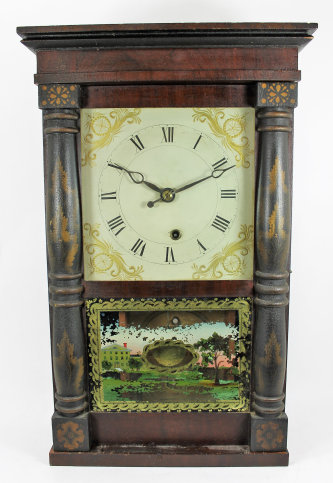

497. $25
“E. Ingraham & Co., Bristol, Conn.”, wood cased mantel clock,
“Doric-Extra”, ca 1880. This clock is 16 ¼ inches tall, made of rosewood veneer, has original door latch and one original glass, and
one replaced. Inside is a replaced paper dial, replaced hands, brass bell, brass pendulum, and the 8-day time and strike movement
that is running. There is a partial label on the back. Ly-Ingraham, pages 270-271. $50-$100.
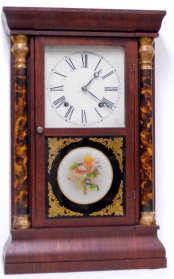
498. $25
“E. N. Welch Mfg. Co., Forestville, Conn.”, ca 1878. The 24 ½
inch high mahogany veneered case is very clean, appears to be completely original, and has had no repairs or additions. The columns
have retained their paint, both glasses are original and there is still some gold on the capitals and bases of the columns. The movement
is spring driven but the case was made to accommodate both a weight driven and spring driven movement. There is a door knob, correct
pendulum bob, coil gong, very good original painted metal dial, and a pair of hands and key. The brass movement is 30-hour, signed,
running, and strikes on a coil gong. Ly-Welch, page 163. $50-$100.

499. $90
E. N. Welch Clock Co. Novelty clock, “The Jewel”, ca 1891. The
3.5” case is solid cut glass, has a porcelain dial and the three hands look to be original. It is signed on the back plate. This movement
was the top of the line for these little clocks, some were made as a striker and a repeater. This one books for over $500 (back in
the day). Ly-Welch, page 249. $100-$200.
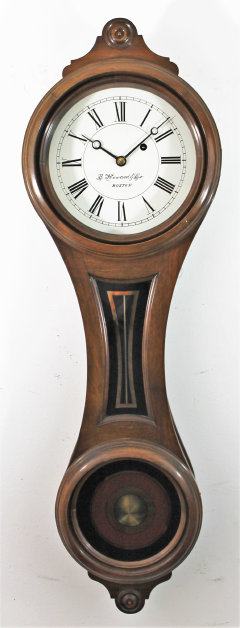
500. $1200
E. Howard Regulator No. 10 reissue, 1976. The walnut case and movement are marked #454 and
dated August of 1976. There is some wear to the left side of the bezel where it is held during opening, and a 1-inch chip of
veneer reglued on the right side behind the upper hinge. Neither is noticeable without close inspection. All glasses
as new, no nicks or scratches to the case; good dial. It is running as expected. A nice mid-tone walnut finish. We sold two last July for $1375 and $1625. $1200-$1600.
Open Interior Movement Open Right side Left side Lower
glass
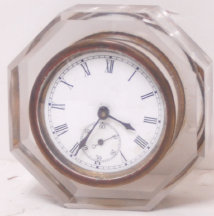
501. $1275
Atkins “Parlor No. 1”, ca. 1855. This timepiece was likely made by Atkins, Whiting &
Co. (1850-1855) or the Atkins Clock Mfg. Co. (1855-1859) and retailed by J.J. Beals & Co. (1849-1861) at Haymarket Square in Boston. There is a label inside, difficult to read behind the wagon spring, that appears to be a Beals label. The time-only, round double-wind
movement is driven by Atkin’s Type III 30-day “wagon spring” and is running. I cannot guarantee that the bottom glass is original,
but it probably should have a reverse-painted design. The upper glass is original with good retention of the gold leaf stencil
but some loss of the blue background. The zinc dial is likely original but may have been repainted; it is signed “J. J. Beals
& Co. Boston”. The rosewood veneer on the case is without damage and I do not see any repairs. The lower door
handle is probably original, but the upper handle appears to be a replacement. It stands 17.5 inches high. Schmitt’s sold
a very similar example in 2014 for $1800. $1400-$2000.
Movement Label Right side Left side
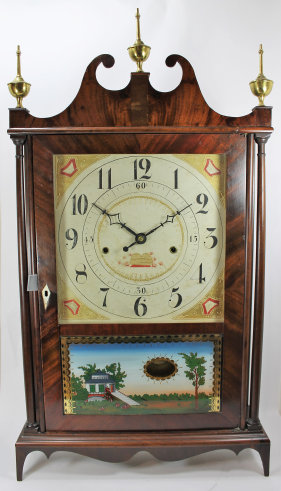
502. $1000
Seth Thomas off-center pillar & scroll, ca. 1825. This is a really nicely restored pillar
& scroll from Seth Thomas’s early clockmaking period. It holds his wood frame 30-hour movement and an original Seth Thomas
dial (note the beehives and flowers below the mainstem). The refinished mahogany-veneered case is in perfect condition with
no veneer repairs, although the scrollwork at the top is a more recent replacement. The feet and skirt appear to be original,
but no guarantee there. The upper glass is old but probably not 1820’s old, and the lower glass is newer, with a very nicely
done repainted but unsigned image. Both glasses have been reputtied into place. There is a nice ivory escutcheon; all
brass urn finials are correct to style for this clock but are newer issue. There are two possibly original lead weights, and
four pulleys, two of which are wood and two are early pewter. When we hung the weights the strike took right off, striking on
an iron bell, but the time side was reluctant and required additional finger pressure to run. I see one gear-tooth repair. The label is very nice, too nice, and is probably a replacement. You can wait for a more original off-center P&S, and pay
a lot more when you find one, or enjoy this one now at a reasonable price. We sold a similar example in July for $1000. $1000-$1500.
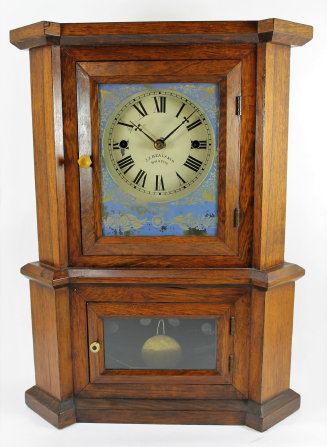
503. $35
Two clocks, Parker Clock Co. “Rotary Hammer Alarm No. 61” and Parker & Whipple Co. miniature. Parker & Whipple made miniature clocks from 1868-1893, followed by the Parker Clock Co. until about 1926, with the latter firm
specializing in alarm clocks. The 3-inch miniature is housed in a dull brass case that might have been gilded, based on the
back cover. It is missing the hour hand and does not run, being wound tightly. The yellowed paper dial is signed “AE Hotchkiss
Patent”. The handle on the back winds the clock and pulls out to set the time from underneath. The 6.5-inch alarm is in
a nickel case with considerable oxidation but a good polish, such as Simichrome, would probably make a difference. There is
a “silent/alarm” toggle in front under the nickel bell, but we did not test it. The clock is fully wound and will run for a
short while. The paper dial is yellowed; the winding key on the back is not correct but works. You can find this clock
on page 191 of Ly’s “American Clocks” Vol. 1. $50-$100.

504. $75
Unknown maker, “Urn” iron-front, ca 1865. The label inside this 13-inch iron-front is too faded
to read and the 30-hour time-and-alarm movement is unsigned. There is an old paper dial, a new minute hand and two replacement
glasses. The clock is running strongly. The hand-painted gold filigree paint is in pretty good shape but the flowers under
the dial are faded. Service label from 1980 on the back. $75-$125.

505. $1600
Charles Kirke wooden works miniature, 1827-1832. Mr. Kirke is known mostly for his pillar
& scroll and column & splat clocks, usually made for George Mitchell, a well-known retailer from 1821-1832. This is
a 20-inch column & cornice with a 30-hour time-only wooden movement. I would guess everything is original, including both
glasses, the wooden dial board and hands, 4-lb iron square iron weight, and even the dust cover over the pulley. There is an
excellent label as well and good original stenciling on the columns. There is considerable flaking to the tablet but the image
is evident. The minute hand has a repair to the tip. The clock will run for a bit and then stop but can be pressed on
with finger pressure on a gear. There are only three Kirke clocks in the Antique Clocks Price Guide, none of which are miniatures
like this; this clock sold at Cottone’s in 2015 for $1600. $1600-$2600.

506. $100
Ansonia “Ringgold”, ca. 1886. A nicely refinished walnut case, 24.5 inches high. The
crest appears to be a replacement and is missing the center circular ornament, and the left return is missing. The glass is
old but the book shows a decorated glass; the dial is new paper. The inside of the case is wallpapered and there is a nice Ansonia
beat scale, no label front or back. The 8-day time and half-hour strike movement is signed and running, striking on a wire gong. No sales in the Antique Clocks Price Guide, so must be uncommon. $100-$200.
